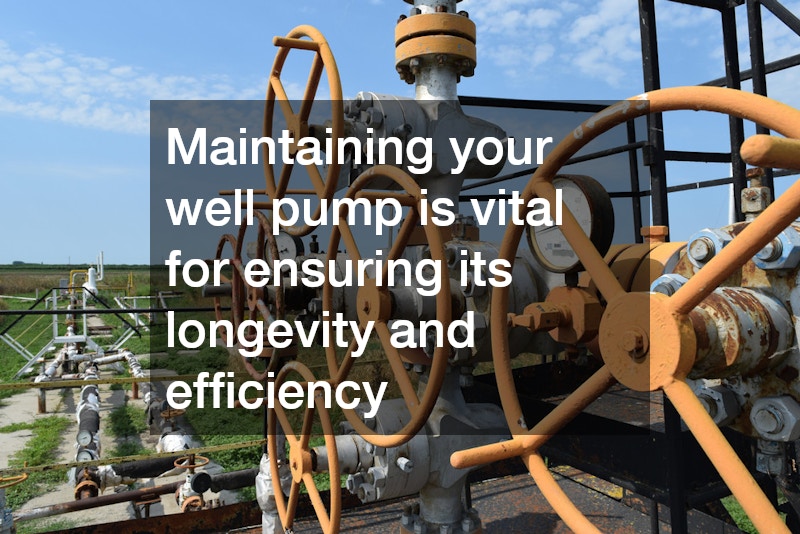Explore essential information and insights that well pump services wish to share about your home fixture. Understanding these key details can help homeowners make informed decisions about their well pump systems.
How to Identify a Failing Well Pump
It’s crucial for homeowners to recognize the signs of a failing well pump to avoid inconvenient water shortages or costly damage. Common indicators include inconsistent water pressure, strange noises, and unusual increases in electricity bills.
Noticing a drop in water quality can also be a sign that the pump is malfunctioning, which could suggest contamination issues or that the water source is compromised.
Many homeowners may question whether their pump is functioning optimally. Regularly monitoring water flow and pressure can help detect inconsistencies. If your faucet runs dry or sputters, this is a telltale sign that your well pump may be struggling. It’s advisable to consult a professional if you encounter these symptoms, as they can perform diagnostics and suggest necessary repairs or maintenance.
Ignoring these warning signs can lead to more severe situations, including complete pump failure. A failing well pump can disrupt daily activities, making it imperative to act swiftly. Homeowners should stay proactive about their well pump’s condition by scheduling regular maintenance checks to catch issues early.
What Maintenance Is Required for Well Pumps
Maintaining your well pump is vital for ensuring its longevity and efficiency. Regular checks on components such as electrical connections, pressure switches, and well casings can prevent minor problems from escalating. Homeowners should also clean and replace filters as needed, as this can significantly impact the well water’s quality.
Another important aspect of well pump maintenance is monitoring water quality and depth. Routine testing for contaminants and ensuring that the water level remains within safe operating ranges can prevent deterioration of the pump. Additionally, scheduling routine professional inspections allows technicians to pinpoint any potential issues before they become major problems.
Furthermore, understanding the specific maintenance requirements of your well pump type is crucial. Different setups, such as submersible or jet pumps, may have unique care protocols. Homeowners should familiarize themselves with these aspects and strive for consistent upkeep to enhance their well pump system’s performance.
When to Replace Your Well Pump
Deciding whether to replace your well pump can be challenging, but it is essential for protecting your home’s water supply. Factors influencing this decision include the age of the pump, its efficiency, and the costs associated with ongoing repairs. Typically, most pumps last about 10 to 15 years, so if yours is approaching this age, it may be time to assess its performance further.
Another determining factor is the frequency of repairs. If your well pump seems to malfunction repeatedly, it may signal that replacement is more cost-effective than further repairs. Homeowners should maintain detailed records of their pump’s service history to assist with this decision.
Ultimately, discuss replacement options with a knowledgeable well pump service provider. These professionals can offer guidance on modern, efficient models and help you understand what would be the best fit for your needs. They can also assess whether your existing setup may have other underlying issues that necessitate a comprehensive upgrade.
What Is Involved in Well Pump Installation
Installing a new well pump involves several essential steps and considerations to ensure a smooth operation. Start by selecting the appropriate pump type based on your specific water needs and the geological conditions of your water supply. The installation process often requires permits and adheres to local regulations, which can vary by region.
Once the necessary permits are obtained, the installation will likely begin with careful removal of the existing pump, if applicable. This process may involve lowering equipment into the well and removing old infrastructure. It is critical to ensure that the pump is installed at the correct depth and angle, as improper setup can lead to inefficiencies or even system failures.
After the new pump is in place, the technician will reconnect the electrical components and run tests to verify functionality. Homeowners should ensure they understand the operation and maintenance of the new pump before the technician leaves. This foundational knowledge will help them manage performance effectively and tackle minor issues that may arise in the future.
How to Choose the Right Well Pump Service Provider
Selecting an appropriate well pump service provider is paramount for ensuring quality service and optimal system performance. Start by seeking recommendations from friends or family who have experience with local services. Checking online reviews can also give insight into a provider’s reputation and reliability.
It’s essential to verify that any service provider you consider is licensed and insured. This protects you from liability during installation or repairs and ensures that the provider meets industry standards. Additionally, inquire about their experience with different types of well pumps to understand their level of expertise.
Finally, discuss warranties and ongoing support options with potential service providers. A reliable company will typically offer guarantees on its work and be willing to provide regular maintenance services. Clear communication is key; ensure you feel comfortable asking questions and discussing your needs openly with them.
By understanding these key details about well pump services, homeowners can make informed choices and better manage their well systems for long-term efficiency and reliability.

